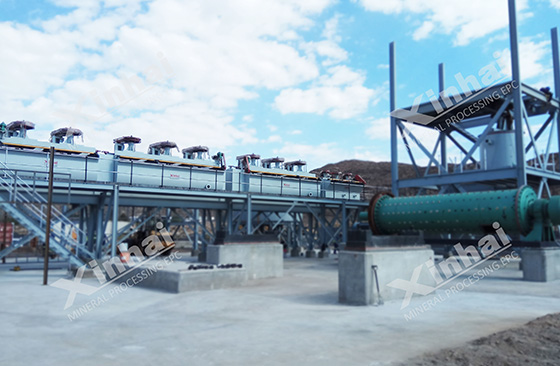With the continuous mining of easy-to-select single gold ores, its reserves are decreasing year by year, and the mining and sorting of arsenic-containing gold ores with complex components has attracted more and more attention. Since the gold inlays in arsenic-bearing gold ores are relatively fine in particle size, they are closely related to gangue minerals such as pyrite and arsenopyrite, and are associated with lead, zinc, and carbonaceous minerals, so the treatment of such minerals is relatively complicated. . When dealing with arsenic-containing gold ore, the concentrator generally adopts flotation separation, mainly mixed flotation, priority flotation and separation flotation. The following will introduce the three kinds of flotation separation technique and the reagent system used.

When dealing with high-sulfur and high-arsenic gold ore, mixed flotation is generally used. Firstly, gold, pyrite and other minerals are mixed and floated out, then pre-treated to remove arsenic by oxidation roasting method, and then gold is extracted by cyanidation method. Or mix flotation to get the concentrate first, then separate flotation to process gold-bearing pyrite concentrate and gold-arsenic concentrate respectively.
During mixed flotation, it is necessary to adjust the pH of the pulp to weakly acidic or weakly alkaline. At this time, the floatability of pyrite and arsenopyrite is better. Sodium carbonate can be used not only as an adjustment agent for the acidity and alkalinity of pulp, but also as an activator for oxidized arsenopyrite, which can improve the effect of arsenopyrite and collectors and the buoyancy. In order to improve the recovery rate of gold, arsenic-containing gold ore should be treated with collectors with strong collection capacity such as isobutyl sodium xanthate, especially for gold ores with high arsenic content. If the arsenic content is not high, butyl sodium xanthate can be used, and if there are many conjoined mineral particles, sec-butyl sodium xanthate and amyl sodium xanthate can be used.
The priority flotation of arsenic-containing gold ore is to suppress the arsenic pyrite and float the gold pyrite concentrate. During the priority flotation, it should be noted that the arsenic content in the concentrate should not exceed the requirements of the smelter. Since pyrite and arsenopyrite have similar crystalline structures, it is necessary to create certain flotation conditions during separation to increase the difference between the surface properties and floatable properties of the two to achieve the purpose of suppressing arsenic and floating yellow.
In priority flotation, oxidants such as potassium permanganate and potassium persulfate are generally used to inhibit arsenopyrite. In addition, it is necessary to control the pH value of the pulp. Pyrite and arsenopyrite have better buoyancy under acidic conditions. When the pH is > 11, these two minerals are inhibited. The floatability of minerals varies greatly, and lime can be used to adjust the acidity and alkalinity of the slurry. In addition, the choice of collector is also an important factor affecting the effect of gold extraction. For flotation of sulfide minerals, it is better to use black drug collectors, such as butyl sodium xanthate or butyl sodium xanthate and butyl ammonium black drug mixed collector. 2” oil can be used as frother when flotation gold-bearing iron ore.

Due to the high content of arsenopyrite during mixed flotation, more oxidants are used, which will increase the cost. Therefore, the heating and stirring method and the vortex layer pretreatment method can be used for separation and flotation. off the oxidant. Adjust the temperature of the pulp to 40-50°C, add sodium carbonate to adjust the pH value of the pulp to 7-9, and stir the pulp by self-priming or filling with air. At this time, the rapid oxidation of arsenopyrite is inhibited, while the pyrite is slightly oxidized, and its buoyancy is improved. Sodium carbonate can also block the oxidation of iron. In addition, the iron filings produced by the friction between the liner and the steel ball during the grinding process will be oxidized and consume oxygen. Sodium carbonate can prevent the oxidation of these iron filings, making arsenopyrite oxidation is not affected.
The above are the three arsenic-containing gold ore flotation separation technique and the drug system. Different ore properties have completely different treatment methods. Xinhai Mining recommends that beneficiation tests be carried out before beneficiation to determine the ore properties and determine the appropriate gold ore beneficiation method. Xinhai Mining can provide general contracting services for gold mineral processing, from ore analysis, design of mineral processing scheme, equipment production, installation and commissioning to later mine management, we can tailor-made for you, so that the project can be put into operation on time and in volume, if any Need, welcome to consult.